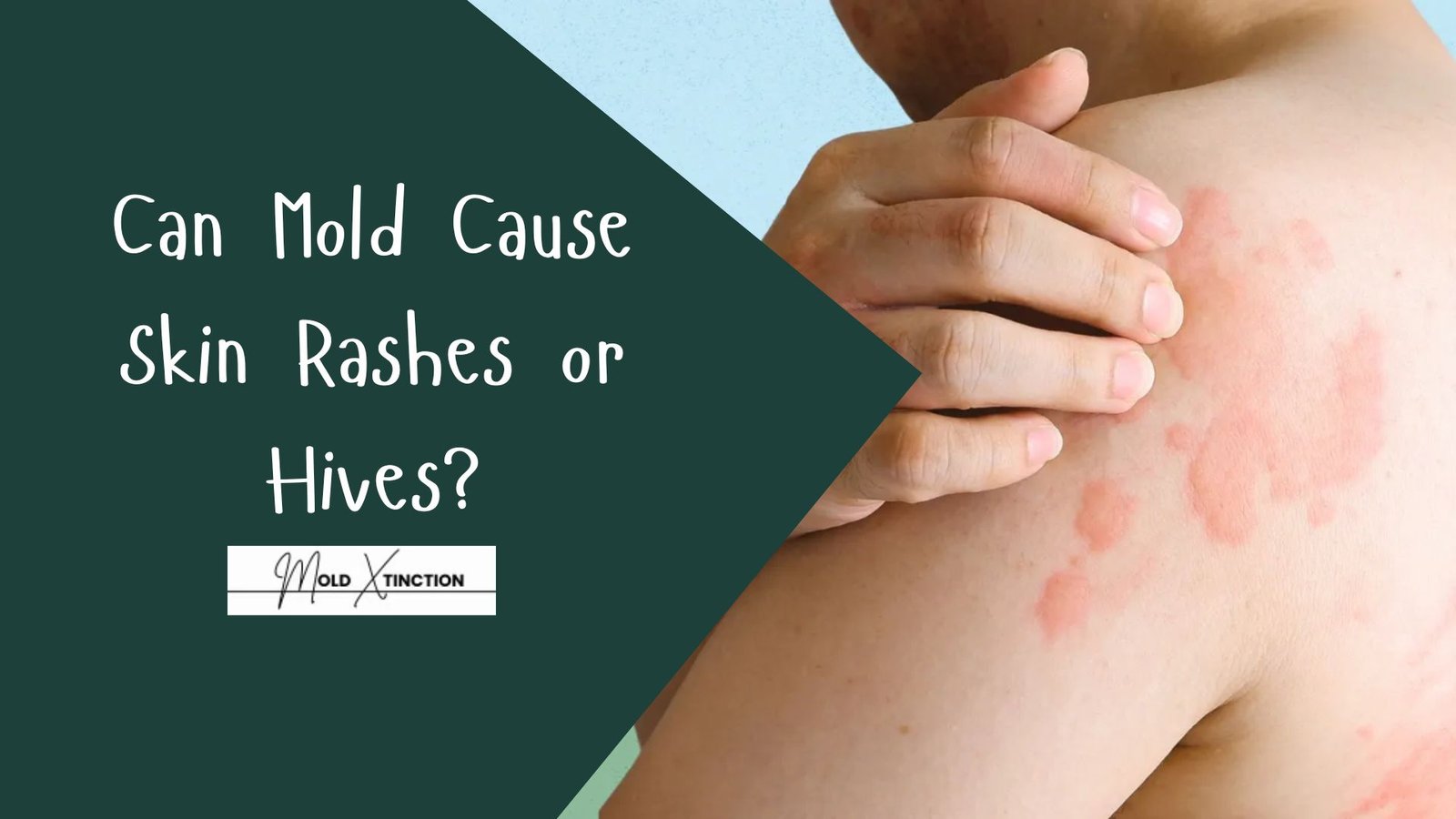Can mold cause skin rashes or hives? One of the issues that people do not usually discuss is that the mold may also influence your skin.
This brings one of the most popular questions: Can mold cause skin rash or hives? The simple answer is yes. It may also cause later effects on the skin which are itchiness, pains and redness because of mold. It may be direct or through an allergic reaction following breathing of a mould spore.
When you have been getting a rash or a rash that you cannot get traced away or even when you are at home when your skin starts to itch this may all be caused by the mold. The ones that are already sensitive to it, children, and the older adults are the most susceptible to it.
This article will help you to know everything about mold and skin reactions with simple and clear language you will understand. We will show you how to recognize the symptoms, the risks, and the measures to undertake that will help you and your family.
What's In This Article
ToggleWhat Are Skin Rashes and Hives?
Before we go further, let’s know what skin rashes and hives are.
Skin Rashes
A skin rash is a patch on the skin that is red, bumpy, itchy, or swollen. It can be hot, painful, or dry. Rashes can develop immediately or gradually.
Hives
Hives are raised red/or skin colored welt type spots on the body that are itchy. They can be just an allergic reaction and can appear anywhere on the body. Hives can last for several hours, sometimes days.
Can Mold Cause Skin Rashes or Hives?

Yes, rashes and hives can be one of the outcomes of mold.
This is done in two ways:
1. Direct Contact
Your body can also respond with an itchy rash or hives when you come into contact with mold or surfaces that are moldy on your skin. This happens more so when you have sensitive skin or if it’s a toxic mold.
2. Allergic Reaction
It may not happen immediately, but a reaction can be caused even if mold is not directly touched: inhaling mold spores will also produce an allergic reaction. The reaction can appear on the skin as hives, redness, and irritation.
What Mold Rashes Look Like
Mold can cause a skin reaction, which is varied in its appearance.
But in most people, one or more of the following will be present:
- red spots or pinkish spots rashes
- lumps or small spots
- Swelling or puffiness
- Flaky skin or dry skin
- Blisters (in rare cases)
- Itching
The rashes can be seen in:
- Your arms
- Neck
- Face
- Back
- Chest
- Legs
- Hands
Mold rashes can be mistaken for eczema, dermatitis, or insect bites by others. Why mention the time and place where symptoms occur?
Who Is Most at Risk?
Not everyone is the same when it comes to mold. Some develop rashes or hives, and others.
The most at risk are:
- Babies and children
- Older adults
- Asthmatics and individuals with allergies
- People with eczema or skin conditions
- People with a weak immune system
- Pregnant women
You don’t have to be in any of these groups to be affected, as long as you are in an environment where mold is living for too long.
How Fast Can Mold Cause a Rash?
This depends on the individual and the type of mold. Some will react in hours, others will take a few days.
Example:
- When you touch the mold, your skin will itch immediately.
- When you inhale mold spores, hives will appear as an allergic reaction.
- The rash will clear up on its own or will persist and worsen if the mold is still present in your surroundings.
Are Mold Rashes Serious?
In most people, mold rashes are a pain but not harmful. But sometimes they can be worse. The severe reaction can be identified by the following signs:
- Puffiness of the lips, face, or throat
- Trouble breathing
- Dizzy or faint
- Fast heartbeat
- Rapid spread of rash
See a doctor immediately if you experience the following signs. It might be anaphylaxis, a serious allergic reaction.
What To Do If You Get a Mold Rash or Hives
If you think mold is causing your rash or hives, follow these:
- Move Out of the Mold
First of all, move out of the room or space with mold. This is the best.
- Wash Your Skin
Gently wash the affected area with soap and water. Don’t scrub it can irritate your skin more.
- Apply Soothing Creams
Apply hydrocortisone or calamine lotion as an anti-itch cream to ease the itching.
- Take Antihistamines
Over-the-counter allergy medicine (Benadryl or Claritin) can eliminate the allergic reaction.
- See a Doctor
Go to a doctor in case the rash is not resolved within a few days or improved. They can give you stronger creams or medicine.
- Don’t Scratch
Although it’s itchy, don’t scratch it can make it worse or become infected.
Signs of Mold in Your Home
There are places you don’t go, and mold can be there. These are the signs:
- Stinky or bad smell
- Stains on walls or ceiling
- Flaking or blistering paint.
- Problem peeling Paint, peeling, or blistering
- Moist air
- Blaksi or grueni flaechens that can be seen
- Increased allergy at home
If you see these signs, most likely the problem is mold, even if you don’t see it.
How to Prevent Mold From Causing Skin Problems
Prevention is better than cure.
Here are some easy tips to prevent mold as the cause of skin problems:
- Fix leaks in time
- Dry wet areas in 24-48 hrs.
- You have to install an exhaust fan in kitchens and bathrooms.
- Do not allow the level of humidity indoors to be higher than 50 percent
- Open windows whenever possible
- Wet spots should be clean and disinfected
- If necessary, use a dehumidifier
- Check hidden areas such as the back of furniture and under sinks
The easiest way to take care of your skin and health is to take care of your home environment.
Am I allowed to Clean Mold Myself?
In case it is a small mold and on solid surface, it may be attempted to clean with:* White vinegar
- Baking soda
- Warm soap, dishwater
- hydrogen peroxide (3 percent)
- You should never use your bare hands in cleaning any mold. Put gloves and a mask on.
But if the mold area is big or if it’s recurring or if it’s stinky, an expert must be called.
Call a Professional Mold Remediation Service
When mold is making you or your family sick, don’t take chances.
Reach out to a professional mold clean-up service now.
They will:
- Find the hidden mold
- Erase it with safe products and tools
- Filter the air
- Fix the dampness issues
- Make your home safe again
Trying to do it yourself can be dangerous and even spread the mold further. The professionals know how to work with it safely and thoroughly.
It’s safer and more affordable…
👉 When you allow moldextinct.com
👉 to reach out on your behalf.
CONTACT US NOW!
Conclusion
Mold is not just a problem for your house, but also for your skin and well-being. If you have been experiencing rashes without any visible cause, itchiness, or hive-like effects, and you have noticed mold around you, don’t ignore it. Mold can cause skin reactions by contact and through allergy; the more you are in contact with it, the worse. The most effective and sensible form of handling the mold problem is by contacting an expert mold cleaning company. They have the ability, armory and experience to eliminate the mold once and for all and not have it recur. Pay attention to your skin, family and emotional comfort. Go get a professional help now, it is worth your health.
FAQs
Does mold cause itchy skin without touching?
Yes. Mold spores are capable of floating around in the air and when they get into your system, you are not aware. Your skin will feel the mold even though you do not touch it. Allergic particles can produce allergic reactions among vulnerable people and one means through which this will manifest itself on the body is through itching, desiccation or rashes on the skin. It may contain redness, burning feeling or unending itching, even though you were not in direct contact with a moldy surface. It is a common story to individuals with allergic or asthmatic problems, individuals with hypersensitive skin. When the symptoms you are experiencing on your skin worsen at home it is always best to assume that one of the reasons might be your indoor air quality.
Is the mold rash contagious?
No mold rashes are not contagious. Mold rash is not a contagious disease that can be transmitted to you by another person, even if you touch their skin or are near them.
Mold rashes are allergies that the person develops towards mold spores in the environment. What this implies is that two individuals sharing the same environment with molds may exhibit one person getting a rash and the other having no symptoms. It simply depends on your immune system, how sensitive your skin is and how much exposure your had to the molds. Yes, you can safeguard yourself but there is no reason to fear that you might infect other people.
What are the signs that will tell me my rash is mold related?
It could be mold in case your rash increases when you are trapped inside specially in certain places of the house such as bathroom, kitchen or basement and you think that you had an encounter with mold (the smell of moldiness or marks of water on the wall).
Another tip off is that you feel better when you’re outdoors or out of the house. Other symptoms you may notice are itchy eyes or sneezing, or even a cough that usually comes with mold exposure. Monitoring the site of your symptoms and frequency can help you find the possible cause of the mold.
Do I need to see a doctor for a mold rash?
Yes. A visit to a doctor is recommended when the rash fails to clear up within a few days or when the rash spreads to other parts of the body, or in case when rash worsens and pain or itching is increased. A doctor can analyze your symptoms and prescribe you creams and a medicine, or anti-allergic medication, and assist you in eradicating other potential causes of the condition.
Some mold rashes can cause infections when scratched excessively, hence early medical consultations are necessary. If you already have skin conditions like eczema, a doctor will also help with its flare-ups due to mold exposure.
Helpful Guide: Will Mold Make You Sick?


